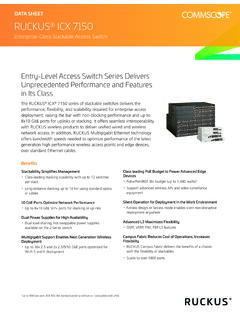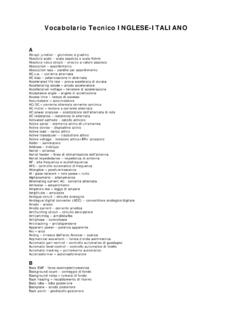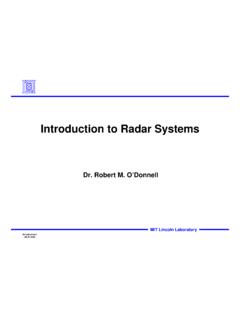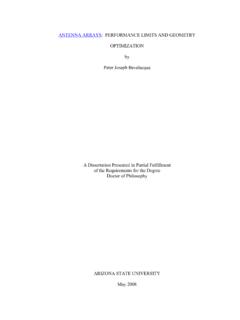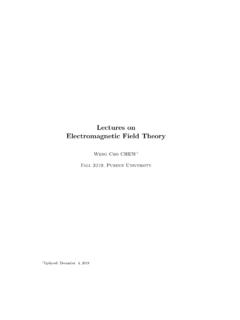Transcription of White Paper: Beamformer Explained - CommScope
1 Beamformers ExplainedDr. Mohamed Nadder Hamdy, Beamformers ExplainedTable of ContentsThe rise of beamformers .. 2 Chapter 1: Beam management procedures .. 3 Idle mode beam management .. 3 Synchronization signals .. 3 Initial access .. 4 Connected mode beam management .. 5 Reference signals .. 5 Connected mode procedures .. 6 Chapter 2: Beamformers basics .. 8 Phased arrays beamforming .. 8 antenna elements .. 8 antenna array patterns .. 8 Analog and digital beamforming .. 11 Analog beamforming .. 11 Digital beamforming .. 12 Hybrid beamforming .. 12 Chapter 3: Building a passive Beamformer .. 12 Adaptive array antennas (AAA) .. 12 Planar arrays .. 12 Column pattern and mutual coupling .. 13 Scanning angle limitations.
2 14 Radiating patterns .. 14 Supporting radios .. 16 antenna parameters settings .. 16 Calibration port .. 17 Example: Practical Implementation with the AAA .. 18 Chapter 4: Building a digital Beamformer .. 19 Massive MIMO .. 19 Massive MIMO dimensioning .. 19 Beamforming type .. 20 antenna elements numbers .. 20 Transceivers numbers and mapping options .. 2264T64R AE Mapping Simulation .. 23 References .. 262 Beamformers ExplainedThe rise of beamformersUnlike traditional antennas that could transmit and receive only on fixed radiation patterns, beamforming antennas dynamically shape their main and null beam directions according to the location of their connected users. Thus, these future-enabling antennas are often referred to as beamformers. Beamforming antennas are unique in their ability to effectively reduce interference, improve the signal-to-interference-and-noise ratio (SINR) and deliver a significantly better end user experience.
3 With the ITU-WRC* adoption of new sub 6 GHz and mmWave frequency bands, and the trend toward extreme spectral efficiencies used in 5G NR , beamformers are becoming an essential weapon in the mobile operator s arsenal. Beamformers offer various configurations and capabilities; each is best suited for a certain environment. Physically, these antennas might look very dissimilar, but all beamformers share three main design philosophies: They contain active or passive array structures. They use digital, analog or hybrid beamforming. They are equipped with multiple radio transceivers 8T8R and higher. AbstractBeamforming antennas are an essential tool for mobile operators as they build out their networks for capacity and 5G NR . For radio planners tasked with developing 5G and capacity build-out strategies, it is critical to have a full understanding of beamforming antenna capabilities, including the variations and appropriate use cases for each type.
4 Without this understanding, planners risk over- or under-engineering parts of their networks, resulting in unnecessary costs, insufficient performance, or both .This paper introduces the principles of beamforming, including passive and active beamforming, different configurations and their underlying technologies . A follow-up paper, Beamformers Explained II, will focus on various actual applications that provide planners a methodology for selecting the right antenna for each situation .*World Radio Conference 5G new radio3 Beamformers ExplainedChapter 1: Beam management proceduresTo understand the operational aspects of beamformers, start with a functional description. The 5G NR specifications include new physical (PHY) and medium access control (MAC) layer procedures to support directional communications.
5 Using 3 GPP terminology, these procedures are referred to as beam management; they include four distinct operations [1].1. Beam sweeping: The radiating pattern covers a spatial area, using a multi-directional beam sweep and pre-specified time intervals 2. Beam measurement: Evaluation of the quality of the received signal at the 5G NodeB (gNB) or the user equipment (UE) 3. Beam determination: Selection of the suitable beam(s), either at the gNB or the UE4. Beam reporting: UE feedback on beam quality and decision information to the radio access network (RAN) Idle mode beam managementIt is essential for the UE to establish a directional physical link connection, with its initial access (IA) to the network. Here the downlink (DL) synchronization signals play an important signals (SS)Unlike LTE, 3 GPP defines a directional version of synchronization signals for 5G NR.
6 This plays an important role in beam management. Synchronization signals PSS, SSS, and PBCH are sent over SS blocks, which in turn are embedded inside larger SS bursts (Figure 1). Each SS block in a burst is mapped to a certain angular direction. By sequentially sweeping different angular directions, a gNB covers a whole cell sector. gNB or gNodeB is the 5 GNR base transceiver station4 Beamformers ExplainedFigure 1: Directional SS blocks transmissionInitial accessAs illustrated in Figure 2, the gNB sweeps several SS blocks in different beam directions. Using beam measurement and beam determination, the UE device first evaluates and then selects the beam with the maximum signal-to-noise ratio or SNR. The fourth key procedure, beam reporting, occurs in one of two ways: Non-standalone mode (NSA) The UE uses the anchoring LTE connection to report the optimal set of directions to the gNBs.
7 The gNB then schedules an immediate random access opportunity (to determine the first available resource the UE can use to transmit without colliding with other devices) for the determined direction with the full beamforming gain [2]. Standalone mode (SA) Here, without the anchoring LTE connection, the UE waits for its gNB to schedule a random access channel (RACH) opportunity. Then, the gNB in each SS block specifies one or more RACH opportunities with a certain time and frequency offset and direction. This tells the UE when to transmit its RACH preamble toward the direction as determined by the gNB. The standalone beam reporting process may require an additional complete directional scan of the gNB for SS block transmission. This further increases the time needed to access the 2: Initial access in NSA mode [3]SS BurstSS BlockOFDM symbols0 1 2 32390 PSSPBCHPBCHSSS56182 RACH preambleSS BurstgNBUEBeam sweep and measurementBeam determinationBeam reportingFeedback on LTETimeSS Block 5SS Block 4SS Block 3SS Block 2SS Block 1gNB schedules directional RACH resourceUE decides which is the best beam5 Beamformers ExplainedConnected mode beam management In connected mode, beam management is required to maintain the alignment of the transmitter and receiver beams as the UEs move an operation defined as tracking [2].
8 Connected mode beam management uses the DL CSI-RS and uplink (UL) SRS, as will be signalsDL channel state information reference signalChannel state information (CSI) is a mechanism by which a UE utilizes a set of reference signals to measure and report back on channel conditions. 3 GPP Rel8 and Rel9 only supported cell-specific reference signals (C-RS), which are utilized for both channel measurements and data demodulation. However, because the C-RS is cell based and not beam or UE specific, it causes excessive signaling overhead when operating in higher MIMO layers and beamforming modes. The introduction of TM9 in 3 GPP Rel10 segregated the reference signals; specifically, the channel state information reference signals (CSI-RS) and demodulation reference signals (DMRS). The segregation enables the decoupling of channel measurement and data demodulation processes.
9 Figure 3 shows two different scenarios for handling reference signals. On the left is a cell-specific example, in which different sets of CSI signals are combined and transmitted to UEs sharing a common beam direction as per 3 GPP Rel8 and Rel9. On the right is a user-specific scenario that takes advantage of TM9 in 3 GPP Rel10. Here, both demodulation signals and user data are transmitted, with user data available on demand [4].Figure 3: Cell- and user-specific RS [4]To determine the CSI-RS allocation, the UE synchronizes with a given cell using the SS bursts, then searches for CSI-RS resources [5] with specified frequency and time offsets (Figure 4).Figure 4: CSI-RS allocation [2]DATACell specific RSUser specific RSR8R9TM9 CRSCRSCSI-RSCSI-RSCSI-RSCSI-RSSS burst periodicity (Tss)Each slot (with 14 OFDM symbols) has two SS blocksFrequencyTimeUEs in connected mode can monitor NCSI,RX CSI-RSs signals to track channel qualityCSI-RSs are associated with time and frequency offsets according to the corresponding SS burst tTCSITCSI6 Beamformers ExplainedUL sounding reference signal The UE transmits the UL sounding reference signal (SRS), which is used to monitor the uplink channel quality.
10 SRS transmission is scheduled by the gNB, which also signals the UE with the resource and direction for transmitting its SRS. The UE may be configured with multiple SRSs for beam management. [5]Table 1: Reference signals for beam management operations [5]Connected mode proceduresNow, with the measurements mechanisms defined, the 3 GPP has further suggested three DL L1/L2 beam management procedures, commonly known as P-1, P-2 and P-3 [1]. These are a set of beam management processes to enable the UE to better receive the downlink beam (data) while in a connected state. These procedures instruct the UE to enable certain TRP beam measurements, for selection and refinement. The concept is similar to the UE measurements triggering events, necessary for handovers and cell reselection. However, here it is meant to keep the optimal beam selected, as the UE roams across the (DL Tx beam and DL Rx beam selection): Function: Triggers UE measurement of TRP Tx beams for Selection of TRP Tx beams (TRP beamforming case) Selection of UE Rx beam(s) (UE beamforming case)Measurements scope Larger, and possibly wider, set of beams Intra- and inter-TRP Tx beam sweep from a set of different beamsFigure 5.






